Simple math trick question – Battle of English Vs Math
The above is an interesting maths question which is really tricky but fun to play along…..
Question :
1 rabbit saw 6 elephants while going to the river.
Every elephant saw 2 monkeys going towards the river.
Every monkey holds 1 parrot in their hands.
How many Animals are going towards the river ???
What is your answer ? [ Scroll down for the answer 🙂 ]
Simple math trick question Answer :
5 Animals.
If you got the correct answer, well done!!
Don’t worry if you did not get the correct answer, coz we (Dad and Mum) got it wrong too. 😉
Why is the answer 5 ?
Let’s go through the question again.
1 rabbit saw 6 elephants while going to the river. <– Hence, 1 animal (rabbit) is going towards the river.
Every elephant saw 2 monkeys going towards the river. <– This is the tricky part, from the sentence it seems to imply each of the 6 elephants saw 2 monkeys going towards the river, hence logically will be 6 x 2 = 12 animals (monkeys) going towards the river.
However, the statement does not explicitly mention that “Every elephant saw 2 DIFFERENT monkeys…”, hence implicit rules apply and infer that the 2 monkeys are the same.
Hence, correct answer is that every elephant saw 2 monkeys, and by inference, the 2 monkeys are the same, hence there exists only 2 monkeys which are going towards the river !! 😉
Finally, every monkey holds 1 parrot in their hands. <– Hence, 2 parrots are going towards the river.
So in total, 1 rabbit, 2 monkeys and 2 parrots (5 animals) are going towards the river.
Hope all of you have fun with this simple english maths question. 🙂
Click for more Brain Teasers, Math Puzzles and Riddles……
Ready for more challenges ?
It is known that relationships can be complicated at times, but the
viral teresa riddle is really twisting people’s brain on what relationship
really means ….
Do you have what it takes to work in Google?
If you can answer what child 7 is doing within 3 seconds (this is one of google’s
interview question), you may have what it takes. 🙂
80% of people get this seemingly easy Math logic question wrong.
Can you calculate the value of ? correctly ?
Are you smarter than 15 year olds ?
Learning Numbers 1, 2, 3 should be easy for everyone, however when they
are combined together made up by some patterns, it is much more challenging,
can you figure out the pattern and identify the next number in the series ?
Let our brain take a break and train our eyes instead.
How fast can you spot the Giraffe below…
[Click on the image for the answer]
More challenging: Are you able to spot all the pandas in the 10 pictures within 3 minutes?
Click on the following picture to begin your challenge.
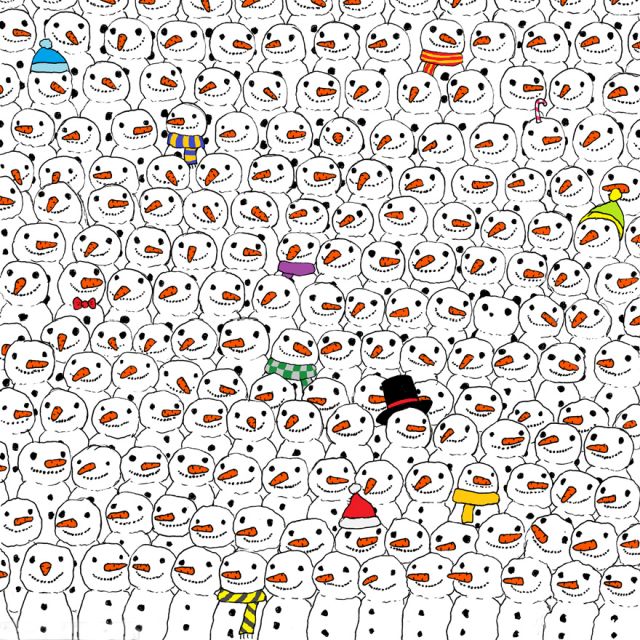
Time to resume our brain training. How badly do you want your Freedom?
Ask the correct question with the Liar and Truth Teller Door Riddle.
Which of the 3 Pool Balls adds up to 30?
Do you know what am I ?
“Let the Fingers do the talking”, how about we do something different
for a change, let our finger do the tracing instead.
Learn how to calculate anyone’s age discreetly.
Can you solve the Unsolved Math Problem ?
Click for more Brain Teasers, Math Puzzles and Riddles……
After using the brain juice, it is time to relax and take a look at the Giant Chicken which has stormed the internet!
Wow, what is this Giant Chicken ?

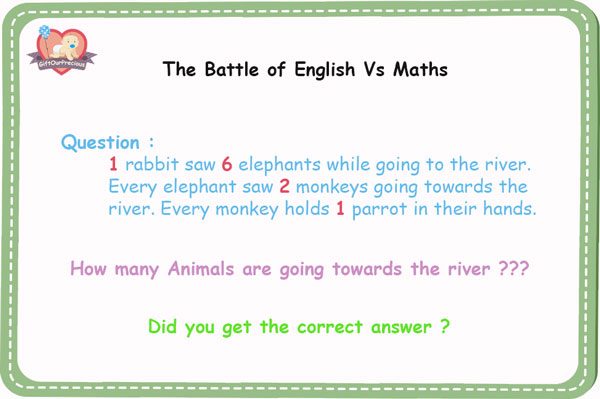
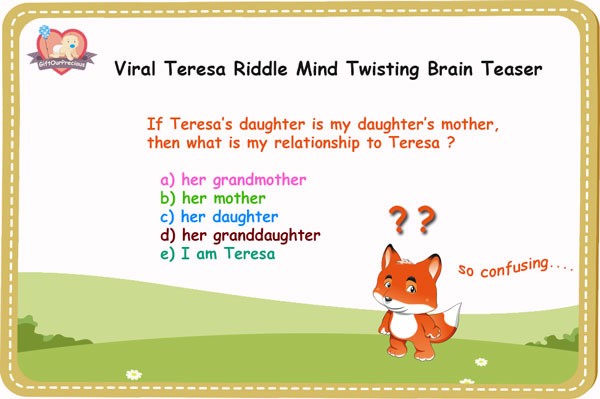
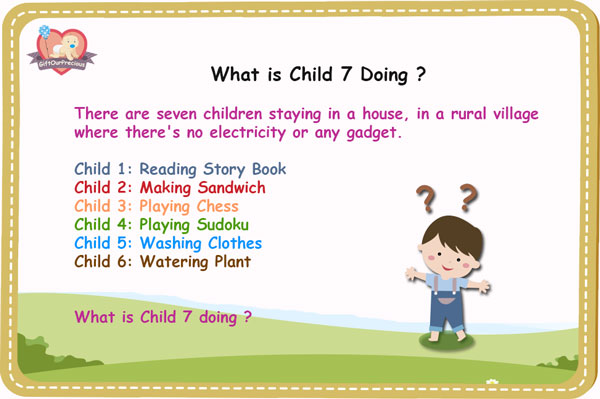
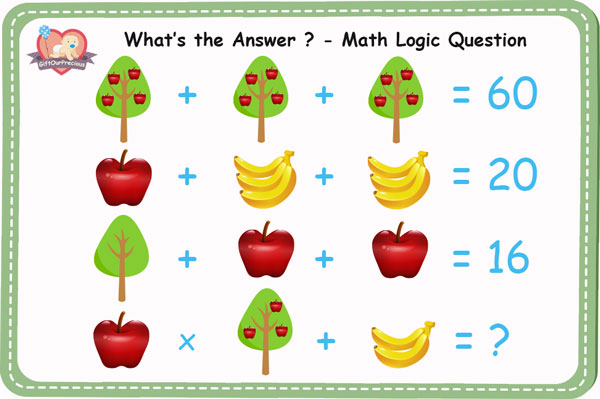
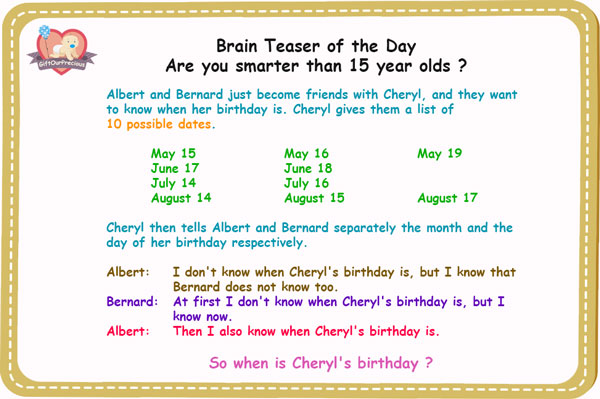
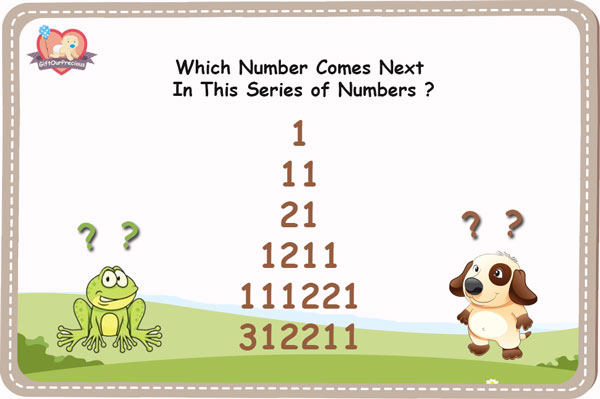
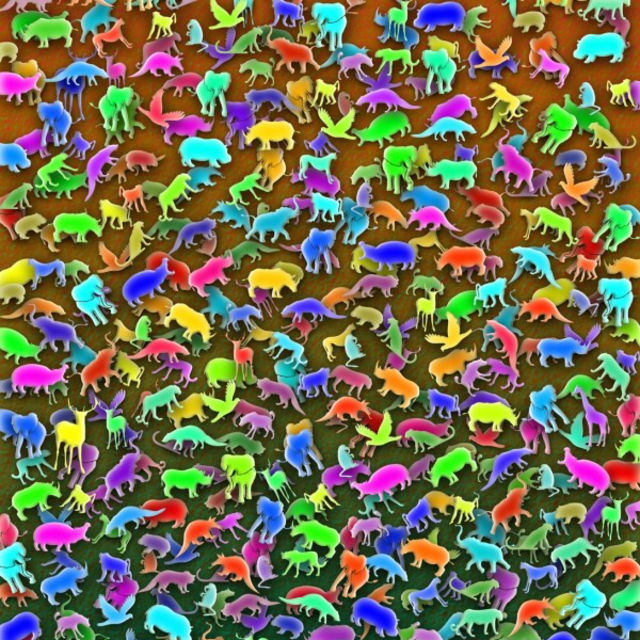
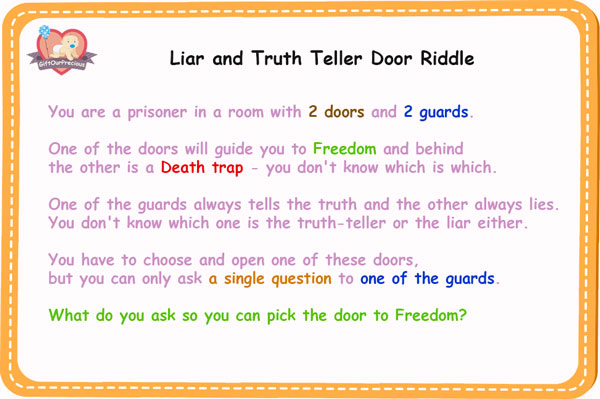
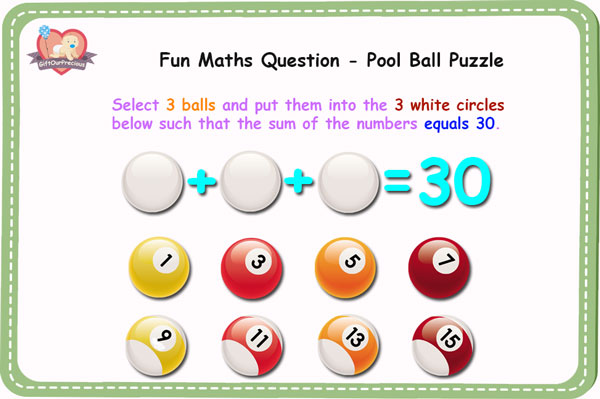
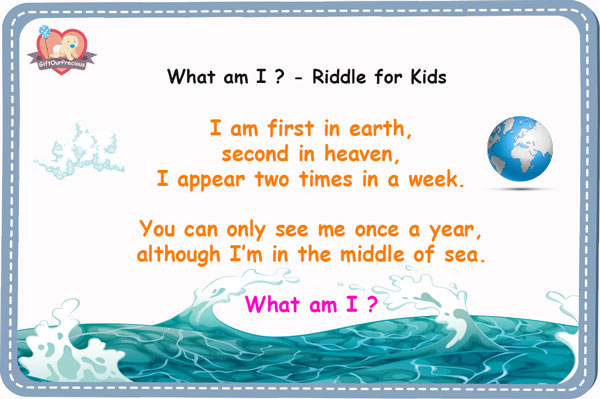
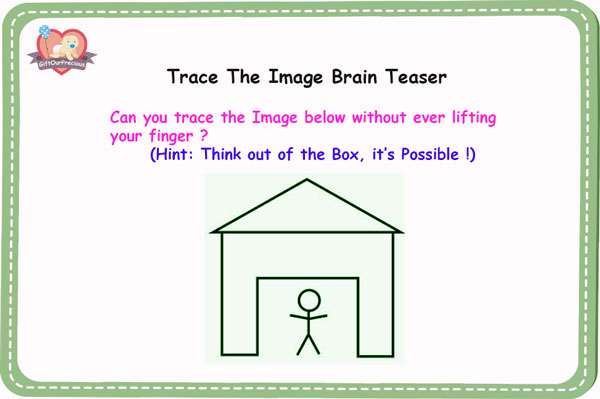
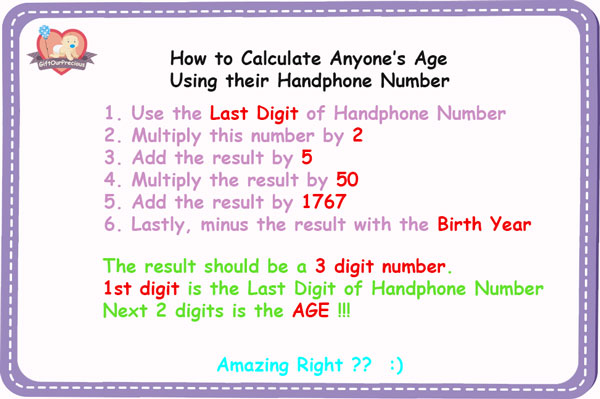
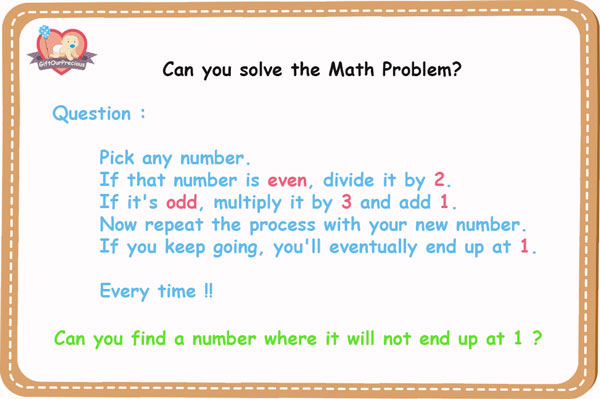






Permalink
Not 5. Only 4. You’re confusing “to” and “towards”. To indicates destination. Towards indicates direction but not destination. Only 4 are going towards!
Permalink
Hi Patrick,
1 rabbit saw 6 elephants “while going to” the river.
“while going to” refers to an action in progress, hence
the rabbit is still on it’s way towards the river.
Agree?
Permalink
The answer could be 25. It doesn’t say if the rabbit saw the elephants as a group or individually. Because every elephant saw 2 monkeys. And were they different monkeys or the same 2 monkeys. Your explanation doesn’t make sense. My answer would be 5 or 25 because it lacks information.
Permalink
Hi Rob,
This is the tricky part of the question, whether the rabbit saw the elephants as a group or individually is not significant as compared to whether the elephants saw different monkeys or the same 2 monkeys.
Let’s recap the statement “Every elephant saw 2 monkeys going towards the river.” The statement does not explicitly mention that “Every elephant saw 2 DIFFERENT monkeys…”, hence implicit rules apply and infer that the 2 monkeys are the same.
Well, the question is worded on purpose to be tricky and that is the fun part right? 🙂
Permalink
What Rob is bringing up is that neither time nor distance are defined in the puzzle. The puzzle does not specify that the “saw” happened at the exact same spot in time. How long was the rabbit traveling? Were any of the monkeys or the rabbit traveling at the oblique? Were the monkeys traveling behind elephants and not seen by them, but seen by elephants on the other side of the river?
Another flaw in this solution’s logic is the assumption that the elephants were NOT also going to the river. The rabbit, while traveling to the river, could well have seen six elephants, also traveling to the river.
What you CAN guarantee is, at a minimum, is that one rabbit, two monkeys and two parrots are traveling.
Permalink
Hi David,
Exactly! If the question does not explicitly mention time, distance, whether the monkeys were traveling behind elephants or any other further info, then that shouldn’t be part of the consideration as the solution right? That kind of assumption should fall under guesswork, imagination and possibility. 😉
Well, since the question again does NOT explicitly mention that the elephants were going towards the river, hence NO assumption should be made that the elephants MAY be going towards the river.
Yes, you are right, with the available information provided, what can be derived is that 1 rabbit, 2 monkeys and 2 parrots are going towards the river. 🙂
Permalink
What exactly do you mean by “implicit rules apply”? Because the question does not say whether every elephant saw the same two monkeys or not, no assumption should be made either way. Because the question does not say whether the elephants are going towards the river, no assumption should be made either way. The question is thus unanswerable without more information.
Permalink
I think everyone on here has missed the fact that this is an English question as much as it is a Math question.
It doesn’t specify that ‘each monkey’ is holding 1 parrot in their hands.
The claim is that ‘every monkey’ is holding 1 parrot in their hands.
There are 2 monkeys, but only 1 parrot!
FYI for everyone debating it…A bird is definitely an ANIMAL!
Permalink
What ever the answer is. don’t take the parrot under animal list. Because parrot is a bird.😂😂😂😂 So totally 3 animals are going towards the river.(1 rabbit and 2 monkey)
Permalink
Hi Vignesh,
You will need to convince that to https://en.wikipedia.org/wiki/Bird or
http://animalkingdom.net/category/birds/ which classifies birds as animals. 😉
Permalink
“Going to” can have DIFFERENT routes, maybe not just yet, but eventually..When “Towards” mean its in their path visually😕😕
Permalink
Hi Kendra,
According to http://www.dictionary.com/browse/towards definition,
1. in the direction of:
to walk toward the river.
Hence, Towards defines direction and does not require visual view. 😉
Permalink
WHILE going to the river means that the rabbit’s destination IS the river…. GOING TOWARDS the river means that the direction they are GOING is TOWARDS the river…. you can walk TOWARDS something without that being where you are going.
Permalink
I also agree. This is awfully written!! The question should ask, “How many animals went to the river and towards it?”
Permalink
I agree with Patrick
Since this is a play on words then we must pay attention to all words!!!
The question is how many animals are going towards the river?
The rabbit is going to the river. Not towards the river there for can not be counted. So that leaves 2 monkeys and 2 parrots witch is 4….. Seeing how it’s a play on words there can be no other right answer!!!
Permalink
Hi Neal,
We agree with Tim Conway’s comment below “Yes, they are two different things. But it doesn’t change the answer here. How can you go to something unless you go toward it?”
We are not making an assumption here, it is a fact that we cannot go to somewhere without going towards it right?
The question states “How many Animals are going towards the river ?” Isn’t it a fact that the rabbit is going towards the river?
Agree that we must pay attention to all words and the meaning behind all words beyond just the surface words matching. 😉
Permalink
You say you’re not making an assumption, but you are. You’re assuming that the 6 elephants that the rabbit sees are together in a group. The rabbit could just as easily have seen 1 elephant every half an hour. There’s nothing in the wording to definitively say. And by that logic each of these elephants could have seen a different pair of monkeys. This would mean there are numerous combinations of meetings/sightings that could each be equally valid, and as such a variety of “correct” answers to this!
Permalink
If you answe the question in its’ literal sense, the actual question says “How many animals are going towards the river?”. In the riddle, the only statement that uses the literal wording “towards the river” is the middle one with the monkeys. Given that fact, coupled with the observation someone else made earlier, I can be driving “to” the mall but at any given point during my journey I could be driving in a direction that is not directly towards the mall, therefore in its’ literal interpretation, the rabbit is not clearly defined as going towards the river like the monkeys are. That’s not to say that the rabbit at some point won’t eventually be going towards the river, but in the context of the statements the only animals specifically stated as going towards the river are the monkeys. While we can also imply that the parrots, by association must also be going towards the river ( carried by the monkeys), the context of the statement does not define “when” the monkeys are holding the parrots ( meaning it could be once they are already at the river). Additionally, the word “every” means a collective, which is different from “each” , meaning the the two monkeys could be holding just one parrot between them, or as many as four (one in each hand). Since the question is asking a very specifically worded question, and the statements are worded in a very vague way that is open to subjective interpretation, I judge that there is no one correct answer.
Permalink
Nope.. TO, and TOWARDS are not the same.. I could be going TO the river, but I have to stop and pick up a fishing buddy in the opposite direction of the river. While I am still performing the action of going TO the river as a destination.. Since the puzzle is both a math, and an English question, you cannot assume that TO = TOWARDS, as it is not implicit.
Permalink
Hi Bob,
Yes, there are subtle difference between TO and TOWARDS.
It is a fact that we cannot go to somewhere without going towards it right?
E.g. I am going to the zoo. (I am going towards the zoo). However, the reverse may not be true.
E.g. I am going towards the zoo. (Does not necessary mean I am going to the zoo.)
Hence, the rabbit is going towards the river (fact, not assumption). 🙂
Permalink
You can go towards the river, without going to the river… but you can’t go to the river without going towards it. So if you’re going to the river you HAVE to go towards it.
Permalink
Sorry, but i agree with Patrick. The sentence clearly states going TOWARDS the river, which would mean the monkeys and parrots that they are carrying – making it 4 animals in total. To and towards are not the same thing. Having a heated debate with my family about this one as they believe that the answer is 5 but i do not agree.
Permalink
To and towards are not the same thing. If you are going towards the river doesn’t necessarily mean you are going to the river, you are just going in the direction of the river. To is the destination. Look up the definition of the two words.
Permalink
Exactly! To and towards are completely different!
Permalink
Hi Sabrina,
According to
http://www.dictionary.com/browse/to definition,
1.
(used for expressing motion or direction toward a point, person, place, or thing approached and reached, as opposed to from):
They came to the house.
2.
(used for expressing direction or motion or direction toward something) in the direction of; toward:
from north to south.
Care to elaborate further on what you mean “To and towards are completely different”?
Permalink
The meaning of both words is the same within the same (context), but the meaning is different depending on whether the word is used as an adjective or a preposition. Thats why it’s only 4.
Permalink
Parrot should not be considered as an animal as it comes under birds section. So the answer should be 3 not 5
Permalink
Birds are animals.
Permalink
I agree 100%.
Permalink
I totall agree with Patrick on this. 4 animals going towards the river… not 5.
The rabbit is going ‘to’ the river, (sooner or later) that is his final destination. Who knows how many other places he goes ‘towards’ (direction) before he to finally goes ‘towards’ the river instead of just ‘to’……
So here is my rationale. …..
………..
OK…. here is where I stand now and why.
1. A bird is an animal. (I checked)
2. The word “to” is a ‘destination’.
3. The word “towards” is a ‘direction’.
4. The word “each” refers to an individual object, person, or thing.
5. The word “every” refers to a group of objects, persons, or things lumped together as one.
Yes… google has been my friend. 😀
As well as Susan Thompson Trawick & Patty Walker Swinford……. and others. As we figured this out together.
The following is ‘my’ reasoning… yours may vary & be different.
The rabbit is going ‘to’ the river not ‘towards’.
The question specifically asks… “How many animals are going ‘towards’ the river”?
The rabbit is out as far as ‘I’ am concerned.
Every elephant saw 2 monkeys going “towards” the river.
The word ‘every’ tells us it is a group of elephants. So they saw the same 2 monkeys.
That is 2 monkeys.
Each monkey carried 1 parrot. That is 2 parrots.
My final answer is 4.
2 monkeys carrying 1 parrot each….. going ‘towards’ the river = 4 animals going ‘towards’ the river.
Permalink
Hi Chuck,
We salute and applaud you for taking your time and effort in researching and explaining your reasoning.
For that, we are willing to close one eye and accept your answer, perspective and interpretation of the question.
Hope that this reply can help you sleep well tonight. 😉
Permalink
Thank you!! I appreciate that. 😉
I love these puzzles to by the way.
Best regards,
Chuck
Permalink
Hmmm! Chuck, the word ‘Every’ does not imply group. If I said every person I saw on the way to work had headphones on does not mean they were all together, I just saw them all on my journey.
Permalink
I disagree with your interpretation of ‘every’ you can say things like “every person in the world needs oxygen to live.” You can refer to “every person” on a global scale as a group but that doesn’t mean that we’re all within eyesight of each other and see the same things.
Permalink
So this is English and Math riddle. The question clearly states: how many animals are GOING TOWARDS the river? In the riddle is the answer: 2 monkies are GOING TOWARDS river. Parrots are NOT going! They are being carried. I think it should be only the 2 monkies GOING TOWARDS the river.
Permalink
Exactly!!!! I agree 100%, it is only 4! BC the English part of the question states that the rabbit going TO the river indicates destination. Going TOWARDS it indicates direction not destination. So, the answer is 4. 4 animals going Towards and 1 aninal going To.
Permalink
My English teacher said the answer should be 4. Because of the question. It asked, “How many animals going towards the river?” She said it doesn’t mean that there going to the river just towards it. We know the rabbit is going to the river so he has an end point. She said its a trick on a trick question for English. But my math teacher said as a math question it would be 5. Because Math is not English we only solve problems. So the real question is is this a Math or English question?
Permalink
I agree 4 because yes the rabbit is going to the River and that’s fine. But the question asked who was going TOWARDS the river not too. Since one is going towards the river doesn’t mean they are actually going there. I could be going towards the river and stop at some other location. It never says that they are actually going TO the river. They are going TOWARDS. These two words have very different meanings. Just because you are going TOWARDS doesn’t mean you are actually going TO that destination. The rabbit was the only one actually going TO the river. The Monkeys with parrots in there hands where going in that direction but doesn’t say they like the rabbit actually going TO. The question asked who is going TOWARDS. You can’t assume the 2 words are the same.
Permalink
Actually the answer is 0. Rabbit saw and Elephants saw imply past tense. The final question is asked in present tense how many are going to the river. We must assume they already went in the past.
Permalink
The rabbit is going to the river, stating a specific destination being the river (the rabbit might not be at the river yet and going towards, but will be making its way there.) The monkeys and parrots are going towards the river and may not actually be heading to the river. The dictionary is splitting hairs and my logic is also splitting hairs.
Permalink
So in this instance going to the river is an intention.
Going towards just indicates that the monkeys and parrots are traveling in the direction of the river, without saying absolutely that the river is the destination.
Hopefully this is a better example of the difference as you can not look at to and towards separately. Cheers
Permalink
Hi Peter,
Thanks for the To vs Towards example and explanation.
So does that mean you agree with the solution?
Cheers 🙂
Permalink
Sorry but to and towards are 2 different things no matter how you spin it
Permalink
Yes, they are two different things. But it doesn’t change the answer here. How can you go to something unless you go toward it?
Permalink
The context does changes it.
Permalink
The riddle says that both monkeys have one parrot in their hands. So how are you arriving at two parrots when the riddle clearly states that both monkeys are holding the same one parrot? If there were two parrots, then the riddle would either state, “Every monkey holds TWO parrots in their hands,” or more likely, ” EACH monkey holds one parrot in their hands.”
EVERY implies the monkeys as a group.
EACH would imply the monkeys individually.
Permalink
Hi Tim,
According to https://www.englishclub.com/grammar/determiners-quantifiers-each-every.htm ,
EACH expresses the idea of “one by one”. It emphasizes individuality.
EVERY is half-way between each and all. It sees things or people as singular, but in a group or in general.
E.g.
Every artist is sensitive.
Each artist sees things differently.
Every soldier saluted the president as he arrived.
The president gave each soldier a medal.
Refer to the 3rd example “Every soldier saluted the president as he arrived.”,
it refers that each soldier is performing an action (salute) individually as a group.
Vs “Every soldier saw the president as he arrived.” ,
it refers that each soldier saw an external event (president) individually as a group.
Hence, the same logic applies to this maths question.
“Every elephant saw 2 monkeys going towards the river.” ,
it refers that each elephant saw an external event (2 monkeys) individually as a group.
“Every monkey holds 1 parrot in their hands.” ,
it refers that each monkey is performing an action (holds 1 parrot) individually as a group.
Agree?
Permalink
I agree with Tim. If you use the same logic applied to every elephant saw 2 monkeys then if every monkey held 1 parrot that would be only one parrot that every one of them held together right?… not “each”
Monkey carrying a parrot.
Permalink
Hi Julie,
The logic applied is similar to the soldier example above.
When an external event (every elephant saw 2 monkeys or every soldier saw the president) is observed,
it implies that each observer saw an external object individually as a group, hence the external object
observed can refer to the same object.
However, when an action is performed (every monkey holds 1 parrot in their hands or every soldier saluted the president)
individually as a group, each individual is performing an action individually (each soldier raise their own hand and point to
their own head to salute or each monkey hold 1 parrot in their hands), hence when each monkey is performing an action
(holds 1 parrot in their hands), the monkey is doing so individually (each monkey holds 1 parrot) as a group, hence 2 parrots in total.
If it is true that the 2 monkeys are together holding the same 1 parrot in their hands, it will mean that each soldier raise their own
hand and all the hands point to just one soldier’s head (the soldier’s head is analogous to the same 1 parrot) to perform the salute and that would just be weird. 😉
Agree?
Permalink
Disagree.
Take John and Jan for example:
John sees Car A, which is a red car.
Jan sees Car B, which is a red car.
I see John and Jan and John tells me, “I saw 1 red car.” Then Jan says, “I saw 1 red car as well!”
Now I tell my friend Joe, “Every person I just spoke with saw 1 red car.” According to what you said, Car A and Car B must be the same car, which may or may not be the case.
Permalink
I also disagree with your statement:
“If it is true that the 2 monkeys are together holding the same 1 parrot in their hands, it will mean that each soldier raise their own
hand and all the hands point to just one soldier’s head (the soldier’s head is analogous to the same 1 parrot) to perform the salute and that would just be weird.”
Saluting is a specific gesture that (unless part of the salute) can only be performed by yourself. If you were to put your hand to someone else’s head then you are not saluting. So by saying every soldier saluted, it must be the case that they performed the gesture correctly (on themselves). Carrying a bird in their hands does not necessarily fall under the same strict definition and an argument could be made that the monkeys are collectively carrying a single bird.
For example:
There are 6 pallbearers. Every pallbearer holds a coffin in their hands.
Permalink
Your question is a battle between English and Mathematics, the question specifically asks how many are going TOWARDS not TO. As pointed out the rabbit is not going TOWARDS the river yet, but there is no argument regarding it’s destination, therefore it is an assumption that it is travelling directly there, so at this point we should rule out the rabbit’s direction. If you applied the same logic to every soldier as you have to every monkey, there would be 2 Presidents. If we include Avey as animals (I’m no David Attenborough. And I don’t trust anything Wikipedia tells me ☺) then the answer is 2 if parrots are not animals, 3 if they are
.
Permalink
only 4 wa*kers going towards
Permalink
Hi Iqbal,
Why 4?
Permalink
If you can accept that each of those 6 elephants saw
2 monkeys and not 12 monkeys in total, why then assume that the 2 monkeys are holding 1 parrot each? The 2 monkeys may be holding the same
1 parrot between them
Permalink
Hi FX,
You may like to read our reply to Tim and Julie’s comment for our explanation.
Permalink
I said two parrots as each monkeys holds one their two hands. Husband says 4 parrots because each monkey has two hands and would have a bird in each.
My concept is that the statement would be the monkeys hold a parrot in EACH hand. But it could also be read as monkeys hold a parrot in his hands meaning one in each and therefore answer would be 7. Comment?
Permalink
Hi Coleen,
“Every monkey holds 1 parrot in their hands.”
The reply is similar to the reply to David’s comment.
“If the question does not explicitly mention time, distance, whether the monkeys were traveling behind
elephants or any other further info, then that shouldn’t be part of the consideration as the solution right?
That kind of assumption should fall under guesswork, imagination and possibility.”
Likewise, without explicit statement such as “Every monkey holds 1 parrot in each of their hand.” or
“Every monkey’s hand holds 1 parrot”,
we can only infer that each monkey is holding on to 1 parrot.
Permalink
I strongly disagree. You cannot infer either to be true. It may be they case that there is 1 total or it may be the case that there is 1 in each hand.
Permalink
The fact that it is a battle of Math and English creates the issue. It is both. If you base the answer on the English alone, the answer is 4 because of the use of the words to and towards. Remember it is a trick question so it won’t be an assumption either.
Permalink
Hi Mark,
We agree with Tim Conway’s comment above “Yes, they are two different things. But it doesn’t change the answer here. How can you go to something unless you go toward it?”
We are not making an assumption here, it is a fact that we cannot go to somewhere without going towards it right?
The question states “How many Animals are going towards the river ?” Isn’t it a fact that the rabbit is going towards the river?
Agree that the question is a mix of both English and maths and that is why this is such a fun and interesting question. 🙂
Permalink
Answer is 3 not 5, you’re saying 1 rabbit ,2 monkeys,2parrots,but in question they asked ,how many animals? So parrots are not animals ,they are birds, ao answer is 3.
Permalink
Hi Prashanth,
Accordingly to http://animalkingdom.net/category/birds/,
Birds are defined as winged animals with two legs that lay eggs.
So, yes, birds are animals. 😉
Permalink
Parrot is not a animal
Permalink
Hi Sohel,
Accordingly to http://animalkingdom.net/category/birds/,
Birds are defined as winged animals with two legs that lay eggs.
So, yes, parrot is an animal. 😉
Permalink
I think people have too much time on their hands and like to argue and the answer is 5 plain and simple oh unless on the way to the river one of the monkeys died……LMAO
Permalink
Hi Cory,
Thanks for supporting the answer with your witty reply. 😉
We welcome all constructive comments, opinions and friendly discussions.
Hope all of you had fun on our website! 🙂
Permalink
3 animals are going towards the river(1 rabbit +2monkey) since parrots are birds hence they are excluded from counting.
Permalink
Hi Anu,
You may like to check our reply to Prashanth and Sohel’s comment. 🙂
Permalink
What if the monkey hold the parrot with both left and right hand so the answer is 1 rabbit 2 monkey 4 parrot 😂😂 I think I was Correct bcoz they didn’t mention that every monkey hold one parrot 🤔
Permalink
Hi Mahesh,
You may like to check our reply to Coleen’s comment above. 🙂
Permalink
The answer is three.
The rabbit is going TO the rivernot TOWARDS the river. In addition “While going to the river” could indicate past tense. E.g. I saw my friend while going to work. As such the rabbit is eliminated.
As every elephant refers to the same two rabbits. Every monkey refers to the same one parrot.
So it is the same two monkeys carrying the same one parrot going toward the river.
The tricks are “going to” vs “going towards” and with the meaning with of “every” vs “every one”.
Permalink
Hi James,
“while going to” refers to an action in progress, hence
the rabbit is still on it’s way towards the river.
The difference between every elephant saw an external event (2 monkeys)
vs every monkey performs an action (holds 1 parrot each) is explained
more clearly via reply to Tim and Julie’s comment above.
“Every soldier saluted (performs an action) the president as he arrived.” vs
“Every soldier saw the president (saw an external event) as he arrived.”
It is a fact that we cannot go to somewhere without going towards it right?
E.g. I am going to the zoo. (I am going towards the zoo). However, the reverse may not be true.
E.g. I am going towards the zoo. (Does not necessary mean I am going to the zoo.)
Hence, the rabbit is going towards the river (true). 🙂
Permalink
But it asked what animals were going towards the river. The rabbit could have gone around in circles and eventually made it to the river. But the question didn’t ask how many animals were going towards the river. I am stuck on the words to and towards which are different.
Permalink
Hi Willi,
Yes, the rabbit could have gone around in circles and eventually made
it to the river, but it doesn’t change the fact that the rabbit is
going towards the river right?
We have explained more in our reply to Neal, Sabrina’s comments above. 🙂
Permalink
I can’t believe how many people think parrots aren’t animals.Thats just sad.
Permalink
Hi Tracy,
We prefer to look at bright side of things and am glad that
this simple fun tricky question is both entertaining and educational.
We get to learn the subtle difference between TO vs TOWARDS and
the surprising fact that Birds are considered animals. 😉
“Never Stop Learning, Coz Life Never Stops Teaching.”
Permalink
The answer is in fact none.
The story is an account of a past occurrence. The last sentence asks the question;
“How many animals are GOING toward the river”.
The answer is; None.
😉
I know Google says 5 but that’s incorrect.
If however, the last sentence asked the question “How many animals WENT toward the river”, the answer would be five.
Permalink
It says its an english test.. but it fails to recognize proper english.. the each (monkey) is carying a parrot in his (hands) hands mean more than one.. hand’s would discribe more than one monky hand… but it says hands.. we have two hands… two birds each…
Permalink
The first trick question…it’s called the battle of English vs Maths….if you answer the question as asked…the rabbit was going “to” the river, not “towards” the river. So wouldn’t the correct answer not be 4?
Permalink
Parrot is a fricking bird and no an animal🤦🏻♂️
Permalink
Answer should be 3..parrots r not animal they are birds
Permalink
Answer is 3, bcz parrot is not animal it is bird 🙂
Permalink
This is completely the wrong answer. The correct answer is 4. The words (TO), and the word (TOWARD) are in a different context. It’s also know as a (preposition).
Permalink
Actually the question implies that the rabbit is already at the river because it says it saw the elephants WHILE GOING TO THE RIVER… Therefore the rabbit is not going towards the river… It is already at the river! The answer is 4! 2 monkeys and 2 parrots are going TOWARD the river!
Thank you!
Permalink
One Rabbit + two monkeys = three animals going towards the river. The question didn’t say every monkey going to the river held one parrot. It just said every monkey holds one parrot. Remember the elephants only saw two rabbits, they weren’t holding anything. Probably the parrots were already at the river. They are birds, they can fly. And the monkeys help them at the river probably to….
Three animals were heading to the river. Parrots are birds they flew above the elephants.
Permalink
To be honest the explanation is flawed. While it is true it never mentioned that the monkeys were not the same it also never mentions that they are. This means there are between 2 and 12 monkeys and the number of monkeys also affects the number of parrots. It also never stipulates that the monkeys are holding different parrots only that they are each holding one. Therefore there is the possibility that two monkeys could be holding the same parrot. I’m not getting into the to vs towards thing because I believe that argument is neglecting the fact this is also an English question and going to the river and towards the river are the same thing. Therefore the answer is equal to or more than 4. Which is an acceptable answer in mathematics. If you really wanna push the rabbit thing the answer would be equal to or less than 3 but I truly believe going to and going towards is the same thing. I know this doesn’t give me infinite authority on the matter but I am a primary school teacher so I do deal with these types of questions in my field.
Permalink
A few months late, but I just seen this today. Lol! There’s a lot of great points, but personally I feel the answer is 2. 🙂 Actual question is “How many animals are going towards the river?”. (Still don’t understand why they used a capital A for animals) I agree with those who spoke about the to vs. towards. So two monkeys. The sentence with the parrots, I feel is like a filler sentence to throw people off. It never said that “each” monkey held a parrot which at first made me think it was 3. But it also didn’t state that the monkeys held the parrot while walking towards the river. So I would think the statement would’ve said the elephants seen the two monkeys going towards the river with 1 parrot in their hands. Hence every monkey could’ve held 1 parrot in their hands at the river, after the river, etc. So going back to the actual question of how many animals are going towards the river, based on the statement I’d say 2. (Just my opinion) 🙂
Permalink
Haha these things make me laugh so much. Don’t understand the bird is not an animal bull, animals are any muticellular organism that can move around. The proposition thing is also wrong, to can be used instead of towards but not the other way around therefore the rabbit is can be said to be going towards the river as he is going to it. Last thing here is the capital use of Animals in the question, there is no need for this unless they are talking of species there fore it would be 3. Rabbit, monkey, parrot. Discuss
Permalink
Wrong! The question asked how many animals are going “TOWARDS” the river. The rabbit was going “TO” the river. Therefore the correct answer is 4 animals going towards the river. Just because the rabbit is going to the river doesn’t neccessary mean it is going in the direction of (towards) the river which is clearly stated for the monkeys and parrots. So 4 it is! Can anybody argue that that is incorrect? If you ignore details like the words to and towards, than you can ignore other details, allowing the answer to be just about anything you please.
Permalink
3 animals. the rabbit, the monkey and the parrot are the only animals going to the river. >.<
Permalink
My point is that the monkeys are taking the parrots to the river therefore they aren’t going on there on their own.
Permalink
Parrot is bird, so it is not included in Animals so Total 3 Animals r going to the Great River 😉
Permalink
But the monkeys are only going towards the river doesn’t mean they are going to go to the river
Permalink
My answer is 3 animals. Because parrot is not an animal it is a bird.
Permalink
In first question their is only 3 animal because parrot is not animal.
Permalink
I say 3. The rabbit and the 2 monkeys.
The rabbit was said to be GOING TO THE RIVER. It merely saw the elephants on its way to the river. So, the destination of the elephants was not stated. There were also 2 monkeys GOING TOWARDS the river. Whether they reach the river or not puts them in the same direction as the rabbit.
The parrots held by the monkeys were NOT GOING to or towards the river. They were being CARRIED TOWARDS the river.
GOING denotes intention and choice which the parrots in this story definitely do not have.
Therefore, by the story, only 3 animals are going towards the river.
😉
Permalink
I say 3. The rabbit and the 2 monkeys.
The rabbit was said to be GOING TO THE RIVER. It merely saw the elephants on its way to the river. So, the destination of the elephants was not stated. There were also 2 monkeys GOING TOWARDS the river. Whether they reach the river or not puts them in the same direction as the rabbit.
The parrots held by the monkeys were NOT GOING to or towards the river. They were being CARRIED TOWARDS the river.
GOING denotes intention and choice which the parrots in this story definitely do not have.
Therefore, by the story, only 3 animals are going towards the river.
😉
Had the question been “how many animals are ON THEIR WAY to the river, I would count the parrots. 😉
Permalink
1 rabbit saw 6 elephants as they went to the river.
Every elephant saw two monkeys walking toward the river.
Each monkey carries 1 parrot in their hands.
1 rabbit
2 monkeys
*** the animals
2 Parrot
*** Birds
The correct answer is only 3 animals
You did ask about animals not birds and animals
How did you know or figure that birds would not fly before reach the river
Permalink
1 rabbit and 2 monkeys total 3 animales.
Parrots not birds…
Permalink
The answer is 10. English wins. 1st line we know 0 is going towards the river. Line #2 we have 2 monkeys going towards the river. So far we got (2). Line #3 the third trick. Read it carefully…. Every monkey (2 monkey) carry 1 parrot in their hands… HANDS.. (4 hands.. monkeys have 4 hands unless it’s a Bimana monkey then they have 2 hands). Line #3 2 monkeys with 4 hands each equal 10. I got my English, Math and Science teacher to work this problem out.
Permalink
Only three animals went to the river: one rabbit and two monkeys.
The parrots did not go to the river. They were only brought there, held by the monkeys against their will. If they were not in the hands of the monkeys, they would have flown away.
So, only the rabbit and the two monkeys had made the decision to go to the river. They carried out their decision by physically going to the river.
If a man would go to the river holding a cat, it is not the man and the cat who went to the river, but only a man holding a cat.
Permalink
OK there’s all this assuming but did anyone take into account time? At what time was this question asked? I’m sure more animals went toward the river before and after the question was asked. But what about when it was asked. The rabbit might have been going to the river but was he in motion at the time it was asked? Towards suggests movement which is over the course of time. To suggests at some point but perhaps not at that moment
Permalink
Then answer should be 3 because parrots are birds not animals.. in question asked only on animals..
Permalink
Actually, “while going to the river,” is a misplaced/squinting/two-way modifier. This construction creates ambiguity as to whether the rabbit or the elephants are going to the river. To clearly modify the rabbit, the clause should be next to the 1 rabbit not the 6 elephants.
In addition, there may only be one parrot because of the inappropriate shift in pronoun number. Every monkey takes a singular verb (is); therefore, the correct possessive pronoun before the word hands should be singular as well. Because the sentence reads, “in their hands” not “in its hands” the implication is that both monkeys are collectively holding one parrot.
With the ambiguity of a misplaced modifier as well as the pronoun shift error, I could clearly make a case for adding 6 elephants and deleting 1 rabbit as well as deleting 1 parrot. That makes my answer 9.
The problem is that this is considered a problem of “English versus Maths” not “English and Math.” Without the proper application syntactical structure, language usage, and language conventions, math word problems can actually be filled with ambiguity.
While I am able to defend my answer of 9, I would also validate someone else’s answer if he/she provided thorough justification and analysis.
What absolutely blows me away is that there are so many different ways of interpreting these few sentences, and there are many plausible explanations.
Permalink
Can I disagree? The rabbit is going to the river, not towards it… The question is who’s going towards it, not to it. In that case, it would be the 2 monkeys and 2 parrots. Yes, no?
Permalink
The answer is actually 3 animals with the possibility of the 1 rabbit because we don’t know which direction the rabbit was traveling while going to the river (e.g. it could have been going around a mountain etc. in the opposite direction to get to the river and not going towards it). Also, “each vs. every is a common grammar issue, even for proficient writers, because let’s face it—they’re very similar words. Although both words refer to something that is singular, ‘each’ refers to an individual object or person, while the term, ‘every’ refers to a group of objects or people lumped together as one.” Therefore, if we apply the rule to the 6 elephants, they saw the same 2 monkeys, but the elephants weren’t going to the river. If we apply the rule to the 2 monkeys, they are holding the 1 parrot collectively & ‘their’ stated is “an error in pronoun/antecedent agreement. ‘Each’ and ‘every’ are both singular indefinite pronouns so the use of the word, ‘their’ is incorrect.” That part should have been ‘his or her’. In summation, we are left with only 3 animals going towards the river with the possibility of the 1 rabbit.
Permalink
There is only 2. Because this is also an english test not just math. The rabbit is going to the river not TOWARDS the river. The elephants never went to or towards the river the parrot even though not animals was never mentioned going to or towards the river. Only the 2 monkeys are mentioned as GOING TOWARDS THE RIVER.
Permalink
Each monkey is holding onto the same parrot because it says their hands
Permalink
Have you ever before had troubles with your web host? I’m open for
referrals as my webhost is dreadful currently.
Permalink
Hi Lillian,
GiftOurPrecious.com has been running on iPage (https://www.giftourprecious.com/webhosting) for several years. We experienced technical issues while upgrading our wordpress, luckily their online live chat and technical support is really responsive and helped us resolve all the issues.
Hope this helps!